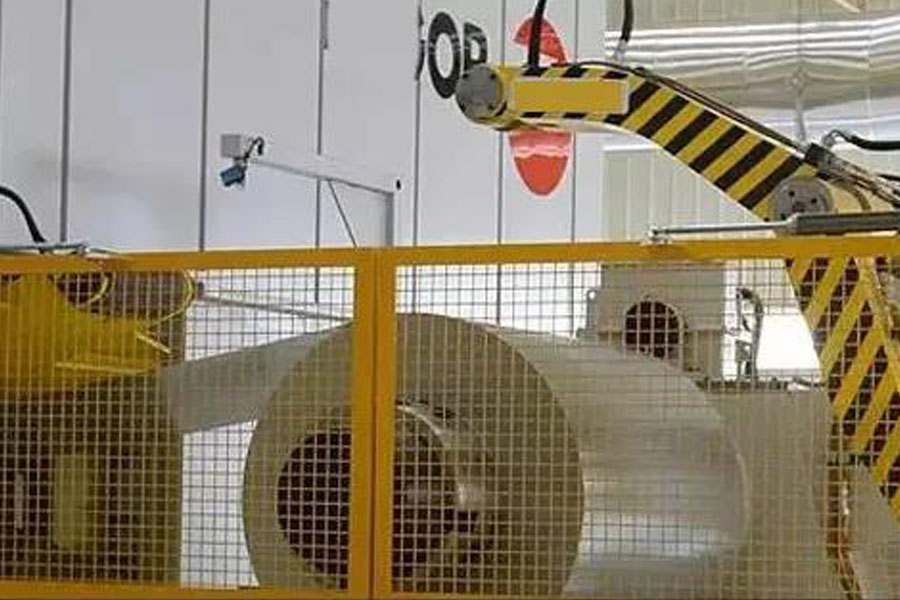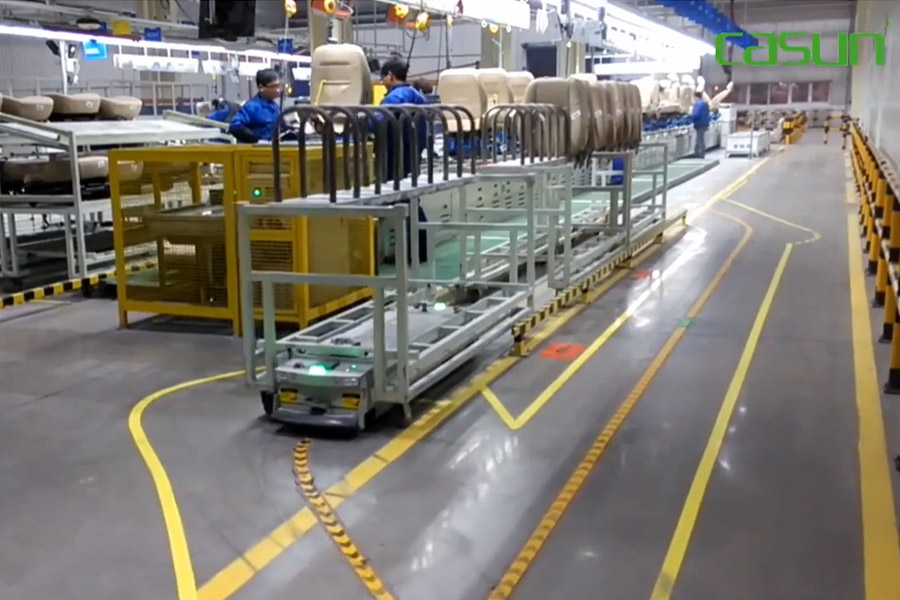In the previous analysis of automobile intelligent manufacturing, we mentioned that the automobile industry is one of the largest industries in the world, and the automobile industry is also the earliest and largest application scenario of AGV.
The vehicle manufacturing of automobiles is divided into four major processes: stamping, welding, painting, and final assembly. In different process links, AGV robots play different roles to help realize the automation and intelligence of logistics handling. So how is AGV used in automobile production workshops? Today, I will mainly talk about the application of AGV in the automobile stamping process.
Contents
- Automobile stamping workshop
- Traditional stamping workshop
- Intelligent manufacturing demand of automobile stamping workshop
- Intelligent manufacturing stamping workshop
- Improve safety
- Reduce cost and increase efficiency
- Digital empowerment
- Summary of AGV application precautions in press shop
- Application case: stamping workshop
Automobile stamping workshop
The car body is composed of multiple steel plates of different shapes. The task of the stamping workshop is to unroll the rolled steel plates, send them to the punching machine, and punch them into the parts required by each car body.
General process flow of automobile stamping workshop:
Raw materials (sheets and coils) warehousing → uncoiling line → large parts cleaning and oiling, small parts uncoiling and shearing → stamping production line → installing molds and debugging the first part-qualified → put into mass production → qualified parts anti-rust → warehouse →
Traditional stamping workshop
The material in the stamping workshop is large and heavy. In the traditional stamping workshop, the uncoiling, feeding, parts stamping, crane lifting, material packing, material distribution, and other links are mainly manual, and then equipped with forklift transportation, and finally the stamping parts bin Transport to the warehouse. With the rapid development of the automotive market, automated production has been widely used in automotive stamping workshops. With the development of future automobiles, automation, informatization, digitization, and intelligence are the future upgrade development directions of automotive stamping workshops.

Intelligent manufacturing demand of automobile stamping workshop
With the improvement of stamping technology and the change of materials, enterprises have higher and higher requirements for intelligent manufacturing in stamping workshops, and more and more attention is paid to the intelligent of factories, which is also one of the focus points for automobile brands to obtain competitive advantages;
In the intelligent manufacturing transformation of stamping workshops of auto companies, there are also long production line introduction and transformation cycles, high costs, complex operation and maintenance, the large impact of line shutdowns, and overall logistics layout flexibility, and low scalability.
Single production line, poor adaptability
The tempo of each process is required to be uniform, otherwise, it will affect the process of the entire production line due to the delay of any process, such as lack of materials, missing parts, waste products, or unexpected problems.
Large area, high site cost
The plant is required to be very large, very long, and very tall (the length of the assembly workshop is generally more than 300 meters), the civil construction cost is high, and the equipment pit (about 2 meters deep) needs to be designed in advance.
Narrow passages and traffic jams
The continuous production line blocked the passage, resulting in long supply lines and inconvenience for people and vehicles to pass by.
Long transportation distance, difficult to maintain
The layout and introduction of the equipment are irreversible, and later transformation is difficult; the conveying equipment is long, and it is inconvenient to maintain linkage after crossing regions. The aerial line needs to design and manufacture a large-area aerial steel platform and a maintenance platform, which is difficult to maintain.
Intelligent manufacturing stamping workshop
In the application of automotive stamping intelligent manufacturing, the current mainstream view is divided into four stages: automation, informationization, digitization, and intelligence. The use of informatization, digitization, and intelligent technology research to improve the overall efficiency of the stamping workshop and improve the quality level of stamping parts, The process technology of reducing the cost of stamping parts and shortening the debugging cycle of new products should be the direction of efforts. Use these new technologies to combine with the traditional stamping processes to intelligently upgrade the process flow:
Including stamping lines, robots, molds, end pickers, conveyor lines, automatic loading and unloading devices, automatic die changing devices, to realize the stamping process, robot running track, end picker connection and picking, automatic picking, automatic packing, automation The production process of mold change is intelligent.
AGV application benefits
The layout of the AGV in the stamping workshop is not just about handling materials. For the layout of the AGV in the production line, it is a complete production line smart logistics solution. The AGV system can interact with the stamping MES system and other data. The entire program has material tracking, Warehouse management, and the ability to interface with various production systems provide an effective guarantee for enterprises to realize informatization, digitization, and intelligent manufacturing.
The application of intelligent AGV is a brand-new technological change for the stamping workshop, and it also lays the foundation for the next step of the company to realize an intelligent warehousing system.
Improve safety
In the production process of stamping parts, the transfer flow of the material box is not static. For example, when the sidewall parts are produced, the logistics volume of the end of the press machine is very large. The length of the sidewall material box is greater than 3500mm, but the transfer space is very limited. At times, bumps and other situations often occur. After the adoption of AGV, this situation is avoided, the maintenance cost of the appliance is reduced, and the safety risk that may be caused is also reduced.
Reduce cost and increase efficiency
According to the estimation of the implementation effect of the smart logistics project in the stamping shop in the automotive field, the use of AGV can save about 20% of energy consumption. In addition, the adoption of AGV also saves logistics operation costs.
Digital empowerment
The intelligent AGV system can interact with the stamping MES system, etc., laying the foundation for the realization of intelligent unmanned stamping warehousing logistics in the next step, and improving the digital and intelligent capabilities of the stamping workshop;
Summary of AGV application precautions in press shop
- Beat and route planning
Due to the uneven production in the stamping workshop, such as the transfer of bins, the peak beat can reach 40s for a bin off the assembly line, and the low value is for a bin at 300s. Therefore, the program and planning route need to be set, and the system needs to judge the beat of the parts. Carry out the adjustment of the AGV route, use different routes and different speeds for different beats, so as to optimize the number of AGVs. - Shock absorption
The AGV walking wheel has strong rigidity and will produce a lot of vibration during the actual operation of the AGV. Each time the positioning pin is hooked with the pallet truck, it will also vibrate. A buffer mechanism is required to reduce the impact of the positioning pin. , Multi-positioning pin positioning can improve the matching between the positioning pin and the pallet truck, reduce the swing during the matching process, and share the force. Therefore, when choosing an AGV, it is necessary to consider the use of spring damping to reduce the vibration amplitude, thereby reducing the failure rate and improving the positioning accuracy. - Counterweight
The floor of the press shop is generally a steel fiber wear-resistant floor. When the AGV pulls about 1 ton of stamping parts and drives on the ground, it will slip off the magnetic strip track. It is necessary to reserve counterweight space before and after the AGV for counterweight adjustment. At the same time, it is necessary to choose a high-power steering wheel to avoid insufficient power due to subsequent adjustment of the counterweight. - Partial load
Since the pallet carried by the AGV is a general-purpose pallet, it is generally designed according to the maximum size. In order to ensure that the distance between the material box and the decoration personnel is minimized, the material box will be placed on one side of the general-purpose pallet instead of the center, so there will be partial load during operation. Case. It is necessary to reasonably arrange casters, AGV counterweights, and program compensation to offset the incorrect driving angle caused by unbalanced load. - Turning radius
The space at the end of the press line is limited. In order to ensure that it does not occupy too much space, the turning radius of the two-way traction AGV is generally required to be less than 1.5m. Therefore, it is necessary to arrange the pallet casters to a certain extent to the center to reduce the turning radius. - Arrangement of steering wheel and magnetic navigation sensor
As the power wheel of the entire AGV, the position of the steering wheel is very critical. If the steering wheel passes through the magnetic stripe route area, the magnetic stripe will be damaged. Therefore, the bias of the magnetic navigation sensor should be considered to avoid the steering wheel pressing over the magnetic stripe route. - Speed selection
The speed of the AGV trolley is not as fast as possible. Driving too fast will increase the braking distance. At the same time, inertia may cause the cargo to fall, posing a greater safety hazard. Excessive speed will also cause derailment during turning, repeated acceleration and deceleration, and energy consumption will also increase. According to the test, the straight-line speed of punching AGV is generally not more than 1m/s, and the turning speed is not more than 0.4m/s. This speed can ensure the stable operation of the AGV. - Operation and maintenance
In the preliminary project planning, it is necessary to comprehensively consider the supervision, maintenance and spare parts costs of the AGV life cycle and the service capabilities of the service company; maintenance training, troubleshooting, etc. need to be dealt with in time to ensure the normal operation of the production line.
Application case: stamping workshop
Solution product: CASUN Intelligent C1 Latent Traction Series
Function Description:
1. Realize automatic empty and full trolley exchange;
2. Material information and trolley are bound by RFID data;
3. The AGV system communicates with the punching machine, and displays the current parts in real time;
4. AGV has omnidirectional operation function.
